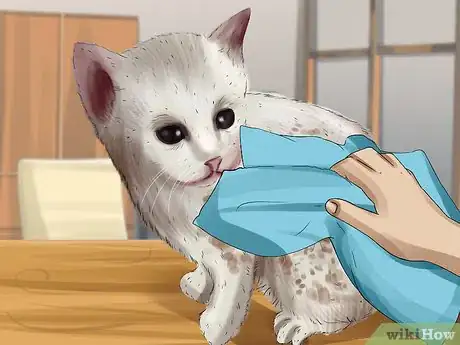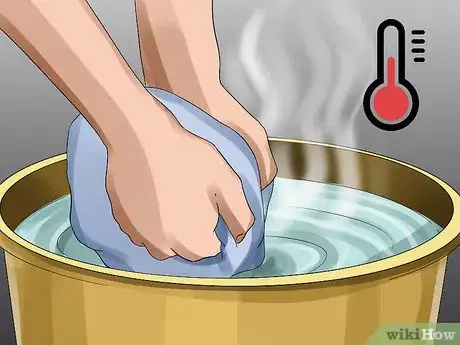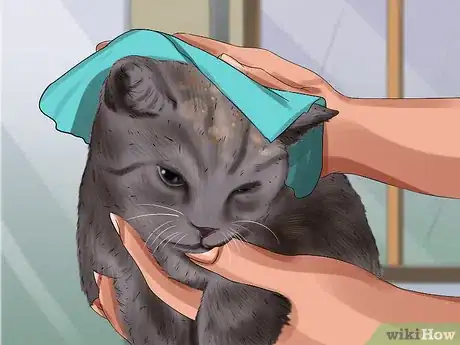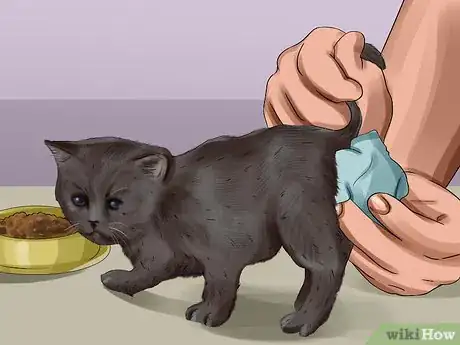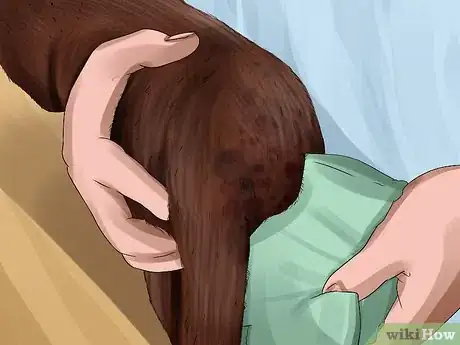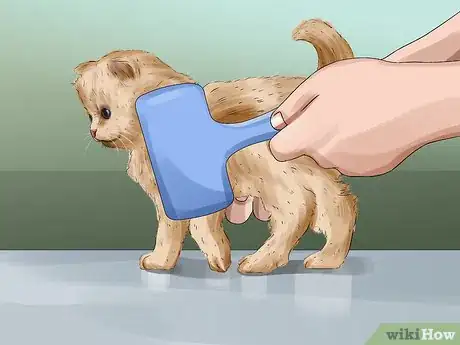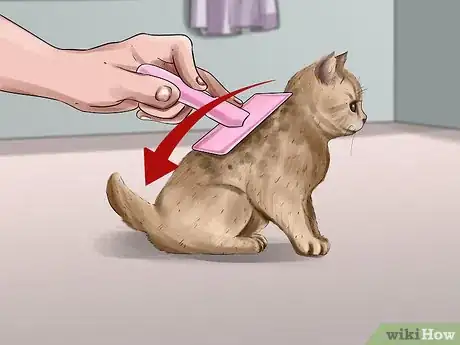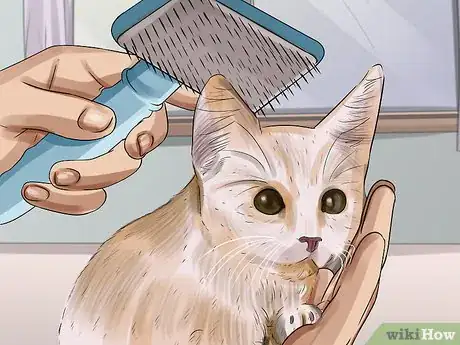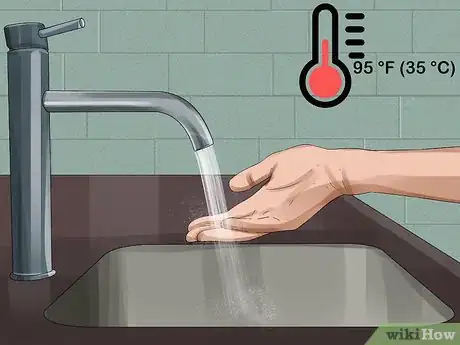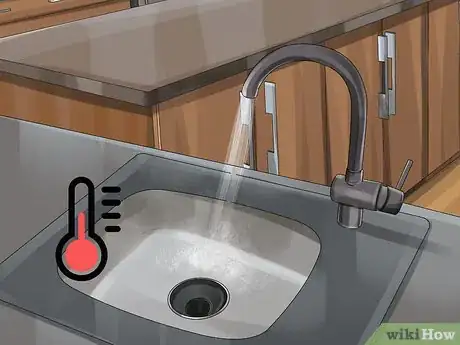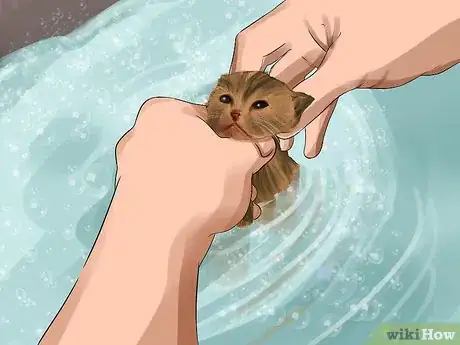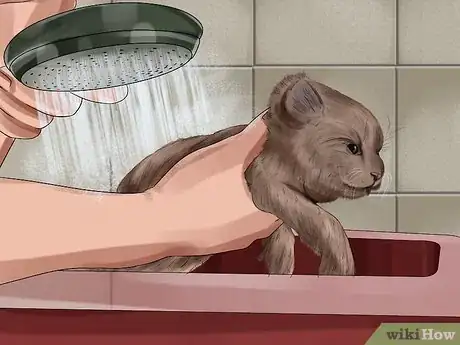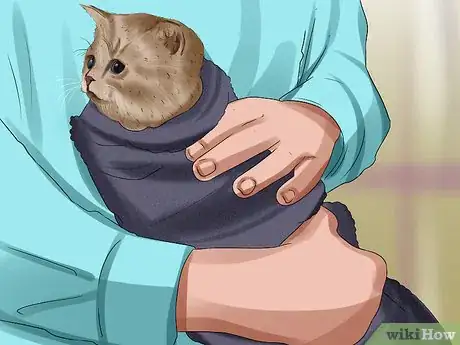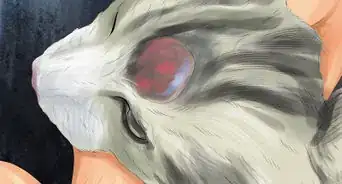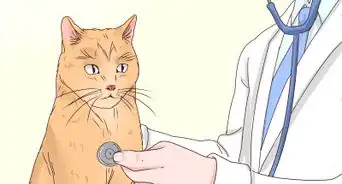This article was co-authored by Melissa Nelson, DVM, PhD. Dr. Nelson is a Veterinarian who specializes in Companion and Large Animal Medicine in Minnesota, where she has over 18 years of experience as a veterinarian in a rural clinic. She received her Doctor of Veterinary Medicine from the University of Minnesota in 1998.
There are 7 references cited in this article, which can be found at the bottom of the page.
This article has been viewed 54,819 times.
An orphaned kitten is helpless, vulnerable, and unable to take care of its most basic needs. As a new cat owner, you must care for the kitten’s personal hygiene needs, since the cat’s mother is not around to wash the kitten. Keeping orphaned kittens clean reduces their risk of disease. Bathing the kitten also teaches it how to groom itself and is an important part of the bonding process between the two of you. The kitten would be typically be bathed by its mother, who would use her tongue to clean the kitten and stimulate it to go to the bathroom. Since the mother isn't around, you'll need to replicate the actions that she'd perform.
Steps
Replicating a Mother’s Cleaning
-
1Spot-clean the kitten if it’s only mildly dirty. Unless the kitten has been rolling in mud, spot-cleaning will clean the kitten perfectly well. Orphaned kittens are very messy. Under normal circumstances, the mother cat would provide the cleaning, but without the mother present, the task falls to you. A daily cleaning of the kitten’s body and rear end will help keep your kitten content and clean.[1]
- Wiping the kitten with a damp cloth will also simulate the tongue bath it would normally receive from its mother.
-
2Wet a soft, dry cloth with lukewarm water. Make sure that the towel is not rough and will not irritate your kitten. Then, wet the towel in lukewarm water. Use a hand to wring the towel out before beginning to clean the kitten. This will result in the wet cloth being roughly the same temperature that the mother’s tongue would be.[2]
- Special kitten shampoos are available in most pet shops, but water is usually enough unless the kitten is particularly dirty. If you’re unsure whether or not you should routinely wash the kitten with a specific shampoo, consult your vet.
Advertisement -
3Gently wipe your kitten in the direction their fur grows. It is best to start from the fore legs and face and move to the back, abdomen, and finish with the hindquarter. Use short, repetitive strokes. Aim to cover about 3 inches (7.6 cm) of the kitten’s body with each wipe, and wipe each section of its body 2 or 3 times. This will replicate the method which the mother cat would use to bathe her kittens.
- Take special care during the cleaning of hindquarter as kittens are unable to clean this area by themselves. It also is the area that gets dirtiest.
-
4Spot-clean any additional dirty spots. Once you’ve cleaned the majority of the kitten’s body, look for any additional spots of fur that are soiled. (They could be matted with mud or feces, for example). Use you damp cloth to rub back and forth in 1⁄2 inch (1.3 cm) increments over the soiled spot.[3] Once the kitten is clean, blot the excess water with a dry towel to prevent illness due to being chilled.
- Since the cloth you’ve used to clean the kitten were only slightly wet to begin with, the kitten’s fur should be mostly dry when you’re finished.
- If the fur is still damp, dry is by lightly pressing the wet patch with a dry towel.
-
5Wipe the rear end of young kittens after each feeding. Kittens less than 3 weeks old need to have their anus and genitals stimulated in order to urinate and defecate. This should be done right after the kittens’ meal time. After the kitten has eaten, massage its entire body, paying particular attention to the abdomen and genital region, with a clean, moist cloth.[4]
- This task would usually be performed by the kitten’s mother. Since the kitten is an orphan, however, it’s your responsibility. Without this wiping beneath the tail, the kittens would be unable to excrete.
-
6Massage beneath the kittens’ tail until they urinate and defecate. Use short, repetitive strokes to massage the kitten’s anus and urinary opening. These strokes mimic the strokes of the mother cat’s tongue, were she there to bathe the kittens herself.[5]
- Since kittens will poop and pee right into the cloth you’re rubbing them with, you may prefer to use a disposable paper towel.
- Kittens develop the ability to go to the bathroom by themselves at around 3 weeks of age, when you can start litter training.
Dry Brushing the Kitten
-
1Brush the kitten’s coat if it doesn’t need a thorough washing. Using a comb or brush is a commonly practiced method for cleaning an orphaned kitten. Brushing helps to stimulate subcutaneous blood circulation and may improve the condition of its skin. Brushing should also mimic the mother’s tongue as she would use it to clean the kitten were it not orphaned.
- This method is inappropriate for rescued kittens if they are too dirty and soiled. However, if your kitten isn’t very dirty and there doesn’t seem to be any contamination to the fur, you can easily clean it by brushing.
-
2Visit a pet store to purchase a brush for your kitten. Take a careful look at the skin and fur of your orphaned kitten to detect the presence of fleas before selecting the right brush for your kitten. If the kitten does have fleas, you’ll need to purchase a fine-toothed flea comb.[6] If the kitten has no fleas, an ordinary pet brush will work well to clean it.
- The presence of even a few fleas on a kitten can lead to serious disease, but most chemical flea products are too strong to use on kittens. Talk to your veterinarian for advice.
- Consult with your local vet if you are confused about which brush to select for your kitten.
-
3Brush your kitten in the direction of its hair from head to tail. Brushing a kitten in the reverse direction can cause unnecessary irritation and hair loss for your kitten. Move the brush through the fur using short strokes, each about 2 inches (5.1 cm) long. This will mimic the way the mother cat would move its tongue when cleaning the kitten. Brush its whole body thoroughly including the abdomen, back, and hindquarters.
- Make sure to clean your brush periodically during the process as dirt and hair may clump on it and make it less effective.
-
4Keep the kitten calm while you’re brushing it. Were the kitten being groomed by its mother, it would feel safe and warm. Replicate this with the orphaned kitten holding it gently (never squeeze the kitten). Avoid making any sharp or sudden movements, especially when you’re holding the kitten. Brush it calmly and slowly, and speak to the kitten using a calm, soothing voice when you’re grooming it.
- The kitten may seem nervous during the first few brushings, but will soon calm down once it begins to trust you.
Bathing a Dirty or Flea-Infested Kitten
-
1Prepare the kitten’s bath supplies. Clean the kitten straightaway if it’s very dirty and covered with mud, dirt, or other detritus. Leaving a kitten in a soiled condition for too long will be uncomfortable for it and can lead to a rash.[7] Cleaning a heavily soiled kitten will mean giving it a bath rather than just a simple wipe down with a flannel. Prepare the supplies before you begin bathing the kitten. Here’s what you’ll need:
- A clean flannel and towel(s).
- Mild hand soap (no harsh chemicals or cleaners).
- A basin or sink.
- Consult with your veterinarian about products to use if your kitten has fleas.
-
2Run the tap water to adjust the temperature of the water. The water temperature should be about 95 °F (35 °C).[8] This temperature will help the kitten stay warm and keep it comfortable. To gauge the water’s temperature, touch the water with your hand, place it on your wrist, and feel the degree of temperature on your own skin.
- It is important to keep the water at a reasonable temperature. The kitten’s skin is sensitive. Water that is too hot can burn the skin easily, while cold water can reduce the kitten’s body temperature.
-
3Fill a basin or sink halfway with warm water. Fill the basin until it’s about 4 inches (10 cm) full before your kitten gets introduced to the water. Do not submerge your orphaned kitten in too much water because it may be too weak to keep itself from drowning. Use your hand to wet the kitten’s hind quarters and lower belly, rather than submerging it in water.[9]
- Wet the kitten gently, and use slow, smooth movements while you’re handling the kitten. This will help it feel safe.
- After you’ve supported the kitten in the sink for a few days, try letting it stand in the water for a few seconds at a time.
-
4Wash a flea-free kitten with a mild pet shampoo. Begin by squeezing a small amount of shampoo on a cloth. Gently rub shampoo over the kitten’s whole body, not forgetting to clean its face, abdomen, legs, and back.[10] Start shampooing its head and move down to the back, belly, and tail. Try to remove the feces or urine excreta from the fur by rubbing it out with the cloth.
- Keep water and soap out of the kitten’s eyes, ears and face. This could irritate sensitive areas and scare the kitten.
-
5Rinse the kitten off completely. After spreading the shampoo on your kitten’s body, rinse it thoroughly by using a cup of water and pouring it slowly over the kitten’s neck and back. Use a damp cloth to clean the soap off of the kitten’s face. Move gingerly to help the kitten feel safe, and avoid splashing water in its eyes.[11]
- Do not place the kitten’s head directly under the tap. This will startle the kitten and make it more difficult to control during future bath times.
- If the kitten seems nervous or afraid, speak to it in a calming voice.
-
6Wrap the kitten in a towel when you’re done. Bathing the kitten should only take 5–10 minutes. Once you’ve finished, dry the body of your kitten with a dry towel. Then wrap the kitten with another soft and dry towel and put it in a warm place until dry. If the kitten seems cold or is shivering, hold it against your body to keep it calm and warm it up.
- You can rub the soft towel on the direction of kitten’s hair to hasten the drying process. This will also build up friction and warm the kitten.
References
- ↑ http://kittenrescue.org/2017/03/raising-orphaned-kittens/
- ↑ https://www.youtube.com/watch?v=qqxzUan3AP8&feature=youtu.be&t=41s
- ↑ https://www.youtube.com/watch?v=qqxzUan3AP8&feature=youtu.be&t=51s
- ↑ https://napahumane.org/our-work/community-cats/orphaned-kitten-care/
- ↑ https://www.petmd.com/cat/centers/kitten/adoption-getting-a-kitten/evr_ct_orphaned_kitten_care?page=2
- ↑ http://kittenrescue.org/2017/03/raising-orphaned-kittens/
- ↑ http://www.kittenbaby.com/cleaning.php
- ↑ https://www.youtube.com/watch?v=qqxzUan3AP8&feature=youtu.be&t=1m28s
- ↑ http://www.kittenbaby.com/cleaning.php
About This Article
If you need to clean an orphaned kitten, wet a soft cloth with lukewarm water, then wring out any excess water. Gently wipe the kitten in the directions that its fur grows, starting with its head and moving back toward its tail. This will replicate the method its mother would use when cleaning her kittens. Pat the kitten dry with a soft towel when you’re finished. For tips from our veterinary reviewer on how to brush the kitten’s fur, read on!
